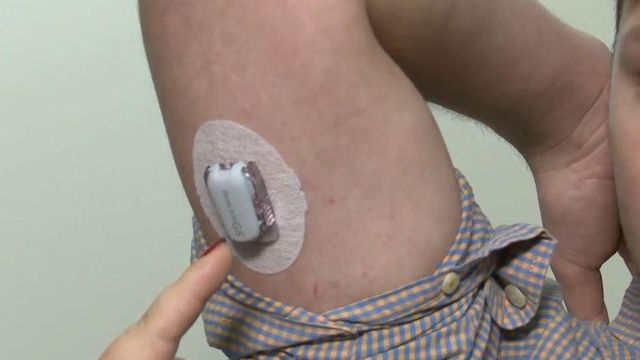UNC, NC State research partnership aims to lighten diabetics' daily burden to monitor blood sugar
For the 400 million people in the world with diabetes, failing to control their blood sugar can become life-threatening. The latest technology is helping diabetics now, but even better devices are on the horizon, researchers said.
Posted — UpdatedThe latest technology is helping diabetics now, but even better devices are on the horizon, researchers said.
WRAL News interviewed three people who have Type 1 diabetes. Each one uses a different type of blood sugar control device.
Dr. Cary Cameron, an internal medicine physician at UNC Health Care, wears a MiniMed-670G insulin pump.
A continuous blood glucose monitor, also called a CGM, provides new readings every five minutes and relays that information back to the pump.
Endocrinology nurse Alex Cass uses the OmniPod.
It holds his personalized settings. A CGM is taped under his arm and sends readings to his smart phone.
Both units can send signals to a device on his stomach, but he still has to do finger sticks twice a day to assure accuracy.
In combination with an OmniPod, Amy Frazier uses the Freestyle Libre.
Frazier passes the CGM over her shoulder.
Each treatment option is state-of-the-art in blood sugar control, but it are still only "semi-closed loop systems.”
Users still need to make adjustments at meal times and for exercise, and there’s still some math involved.
UNC's Dr. John Buse is a national leader in assessing new technologies to lighten the burden of daily blood sugar control for diabetics.
“The so-called ‘closed-loop system,’ where the patient is basically a bystander, we're almost there,” Buse said.
Insurance can help cover costs, but the costs of these complex systems are still a concern.
“Probably around $10,000 a year,” Buse said.
Because of the cost, Buse is excited about UNC’ partnership with a North Carolina State University biomedical engineering lab with Dr. Zhen Gu.
Gu's goal is to shrink blood sugar control down to the size of a painless patch on the skin.
“Each patch has tens of thousands of micro-needles,” Gu said
Micro-needles will contain microscopic glucose-sensing components and tiny storage units for insulin.
“Our concept is trying to mimic the function of the normal pancreas,” Gu said.
Researchers describe it as a pancreas on a patch that releases insulin instantly as needed. There’s no batteries or buttons — just chemistry.
“So, if we can get the chemistry right, it should work every time,” Buse said.
A 2015 study displayed good glucose control in mice, so now testing is underway on larger animal models.
It could still be years before human trials. Until then, the current devices already make life better for diabetics like Cameron.
“It actually makes you think less about your diabetes,” Cameron said.
Related Topics
• Credits
Copyright 2024 by Capitol Broadcasting Company. All rights reserved. This material may not be published, broadcast, rewritten or redistributed.





